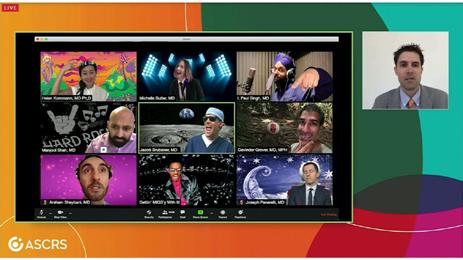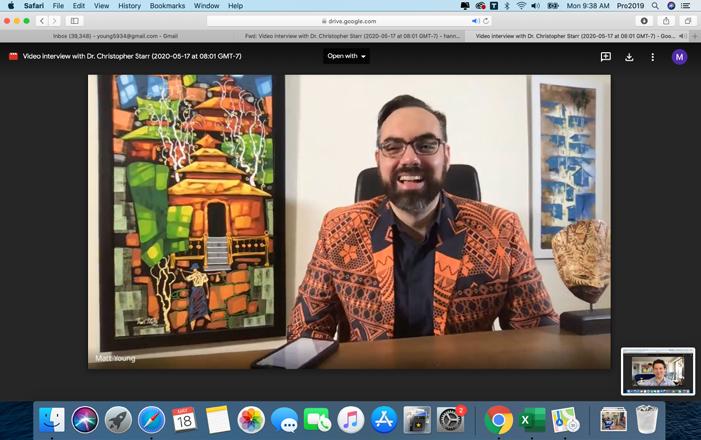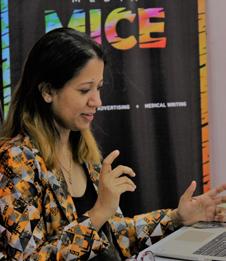
7 minute read
The MIGS rock stars get-together, see what you missed
MIGS Tops the Charts #1 Hi t: by Brooke Herron
Eat your heart out rock bands: The MIGS’y group is the next big thing. . .
These days, it’s all about MIGS — or micro-invasive glaucoma surgery. And why not? Versus more invasive measures, it has a higher safety profile, less recovery time, fewer complications — and has been shown to be effective at decreasing intraocular pressure (IOP), as well as dependence on medications. No wonder ophthalmologists have been singing MIGS’ praises!
And as it turns out, some were literally singing: The symposium Gettin’ MIGS’y With It was released on the second day of the American Society of Cataract
and Refractive Surgery Virtual Annual
Meeting (ASCRS 2020). From the team that brought hits like MIGS Street Boys and a Little Help from my MIGS, this course featured new releases in clinical pearls and patient selection criteria, from chart-topping ophthalmologists from around the world. [Editor’s Note: While we aren’t a record label, we suggest Under Pressure for the album’s name.]
Pick good musicians for your band
MIGS’y With It: Targeting the Canal, Dr. Michelle Butler began by describing several MIGS procedures: stenting with the iStent inject (Glaukos, California, USA) or Hydrus (Ivantis, California, USA); focally ablating with a trabectome; excising with a Kahook Dual Blade (New World Medical, California, USA) or goniotome; and unroofing the trabecular meshwork with GATT (Gonioscopyassisted transluminal trabeculotomy or Omni (Sight Sciences. California, USA).
“There’s really no clear MIGS winner that works every time, for every patient, in every surgeon’s hands, but I would advise to get comfortable with at least a few of these,” said Dr. Butler.
She explained that when deciding on a MIGS procedure, there are patient and disease factors that influence the decision. Disease factors include: type of glaucoma, severity, stability/progression, current treatment, target IOP and angle anatomy. For patients, lens status, medical conditions, expectations and cost/insurance should be considered.
“If there’s already a visually significant cataract and the patient is already going into the operating room, that is a great time to try to improve the overall glaucoma control,” continued Dr. Butler, adding that the status of the fellow eye should also be considered, as well as the patient’s medical health (including age).
On the plus side…
MIGS plus devices bridge the gap between trabecular bypass/ablative procedures and traditional glaucoma surgeries, said Dr. Helen Kornmann.
These procedures are similar to a trabeculectomy — where a subconjunctival bleb is created to profoundly lower IOP — but also similar to MIGS in that they are less invasive with less postoperative intervention, leading to a faster visual recovery. Two MIGS plus devices are the XEN45 (Allergan, Dublin, Ireland) and Preserflo (Santen, Osaka, Japan), which are designed to limit hypotony. Additionally, the devices are made from materials specifically to limit an inflammatory response.
The XEN45 comes loaded on an injector with a 27G needle, and though designed for ab interno insertion, it can also be used via the ab externo approach.
Dr. Kornmann also explained that surgeons should know some of the pros and cons for each MIGS method — this can help decide which technique is best suited for the patient. “The ab interno technique offers speed, simplicity and lack of suturing,” she said.
“Meanwhile, the closed ab externo approach also offers speed, simplicity and lack of sutures, but additionally, it also frees the surgeon from the ergonomic limitation of placing the stent in the superonasal quadrant,” said Dr. Kornmann. There is also no corneal incision and it’s less likely to get stuck in the Tenon’s capsule — however, she said that it can also be a challenging procedure.
The open ab externo technique allows for the most precise placement of the XEN, deeper into the sub-Tenon pocket, which has been shown to lead to lower IOP, the risk of bleb failure and erosion. “However, it is more invasive,” noted Dr. Kornmann.
Chomping on Challenging Cataract Cases

with Golden Apple Teaching Award Recipient by Joanna Lee
Every year at the American Society
of Cataract and Refractive Surgery
(ASCRS) congress, several presenters would share their challenging cases in cataract surgery and their pearls of learning for teaching purposes. In a fun incentive, their videos would then be in the running for the conference’s Golden Apple Teaching Award. This year, seven participants vie for the award while showcasing their latest techniques and innovations in mitigating difficult cases of cataract surgery.
Seven nominees share sweet surgical tips
The session was moderated by Dr. Kevin Miller with an enthusiastic and supportive panelist comprising Dr. Deepinder Dhaliwal, Dr. Kendall Donaldson, Dr. Nicole Fram, Dr.Tal Raviv, Dr. Jonathan Rubenstein and Dr. Mitchell Weikert.
The first in the series of videos was The Amazing Cataract Houdini! by Dr. Cristos Ifantides. His reel unfolded like a thriller movie which revealed the “mystery” of the disappearing cataract during a Zepto (Mynosys Cellular Devices, California, USA) capsulotomy on a patient with white cataract. He demonstrated how Zepto is perfect for complications like this as it does not require tripan. Just like tension on a balloon, Zepto keeps the tension on the pressurized capsule and prevents it from running out while everyone learned that cataracts can indeed completely liquefy!
The next video proved to be a contender when Dr. Minu Mathen from India, deftly demonstrated in The Morgagnian Challenge video how he performed the surgery manually. Dr. Miller reminded the audience that being in a teaching university setting helps one see more types of cases. In this case, Dr. Mathen said he sees three or four Morgagnian cases every week in his practice.
In what was described as an “interesting approach to a common problem” by one of the panelists, Jeddah-based Dr. Ahmed Samir’s video, Double-Flanged Polyprolene
Suture for Scleral Fixation of Cionni
Capsule Tension Ring, showed a simple, time-saving technique to help lens subluxation. Dr. Deepinder said his technique can be considered as the “Yamane technique of 2020”. A bungee cord injury case became a lesson in Traumatic Cataract…And Then Some! where Dr. Gregory Ogawa presented detailed teaching points from the patient’s anterior vitrectomy. The next video was easy to follow as Dr. Bruno Trindade from Brazil, shared about Toric IOL with Intraocular Pinhole:
A Paradigm Shift in the Treatment of
Keratoconus. His 41-year-old patient had undergone CXL and intra-ring implantation and many trials of contact lenses. “Despite the effort, his uncorrected vision still poor. So they did a clear lens extraction followed by implantation of low-powered IOL together with the extra-focus pinhole in the ciliary sulcus,” said Dr. Trindade. Four months after his procedure, he had a best corrected 20/20 vision but couldn’t tolerate spectacles and ‘ghosting’. So Dr. Trindade performed an IOL exchange under the intraocular pinhole to a toric lens. The result was a 20/16 uncorrected vision. “The pinholes were used to address higher order aberrations in these eyes,” he explained. Using toric implant with pinhole showed outstanding results. He also listed lesson points and the ideal candidates for this approach highly suited for contact-lens intolerable patients. In Posterior Polar with Pre-Existing Defect, Dr. Shail A Vasavada from India, highlighted the importance of the closed chamber technique and femtodelineation as well as how toric IOLs can be considered “in-the-bag” with a strong posterior capsulorrhexis “without worries of stablility of the IOL”. The last teaching video came with a curiously long and independent moviesque I Like The Bag, I Like Separation,
I Don’t Like Vitreous! I Definitely Don’t Like Vitreous Cavity! Supracapsular
ISHF. In it, Dr. Soosan Jacob (India) demonstrated the supracapsular glued IOL technique along with the use of a paper clip capsular stabilizer.
And the Golden Apple Teaching Award winner is…
Finally, 130 participants in this session voted for the winner. This year, due to the virtual nature of the meeting, the winner will instead receive gift certificates from Apple. Dr. Miller announced Dr. Bruno Trindade from Brazil as the winner. Not to be missed are this session’s engaging discussions in between each presenter’s videos featuring excellent learning points with constructive comments and pearls of experience which the panellists have richly added to.
Take a bite out of some juicy cataract wisdom from doctors and panelists in this symposium session.
Special Thanks
Thanks to all the CAKE Talks video interviewees that helped share their knowledge from the West to the East. They include: 1) Francis S. Mah, MD, Chair, Cornea Clinical Committee, ASCRS 2) Julie Schallhorn, MD, Young Eye Surgeons (YES), ASCRS 3) Christopher Starr, MD, Associate Professor of Ophthalmology, Weill Cornell Medicine
Be sure to check out their unique video interviews, moderated by Media MICE CEO and CAKE and PIE Publisher Matt Young. We are rolling out these videos all week long at cakemagazine.org.
1

2
3



CONTENT MARKETING + ADVERTISING + MEDICAL WRITING
6001 Beach Road, #19-06 Golden Mile Tower, Singapore 199589
Phone: +65 8186 7677 | U.S.: +1 302 261 5379 E-mail: enquiry@mediamice.com Web: www.mediamice.com



